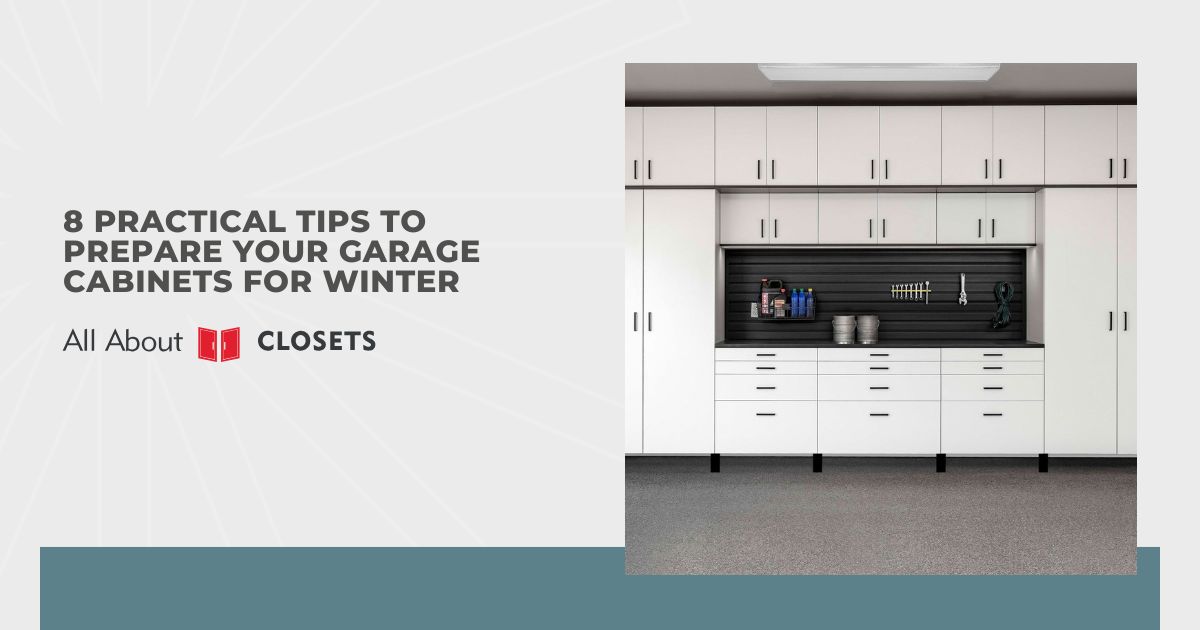8 Practical Tips to Prepare Your Garage Cabinets for Winter

As temperatures drop and winter approaches, many homeowners focus on insulating their homes while the garage remains an afterthought. However, your garage cabinets need just as much attention as the rest of your space. Cold weather, moisture, and road salt can all affect cabinet materials and the items you store inside. Without proper preparation, those elements can lead to warping, rust, and clutter that make your garage harder to use during the coldest months.
Preparing your garage for winter doesn’t have to be overwhelming. It just takes a little planning and maintenance. A few simple steps today can protect your investment and keep your space running efficiently all season long. When you take the time to inspect, clean, and organize your cabinets now, you’ll save yourself from bigger headaches once the freezing weather sets in.
Here are eight practical and effective ways to prepare your garage cabinets for winter:
- Inspect your garage cabinets for damage
- Clean and declutter cabinet contents
- Organize items by seasonal use
- Add moisture protection
- Seal gaps and weatherproof the area
- Protect metal and wood surfaces
- Elevate and secure hazardous materials
- Plan for easy winter access
Keep reading to learn how each of these simple yet impactful steps can help protect your investment and keep your garage running smoothly all season long.
Inspect Your Garage Cabinets for Damage
Before winter sets in, take the time to look over every part of your garage cabinets. Check for loose hinges, cracked wood, or rust spots—issues that can worsen once the temperature drops. Cold weather and moisture can make small imperfections turn into costly damage, especially when freezing water expands in gaps and seams.
I like to go over the surfaces with a flashlight and tighten any hardware that’s come loose. If you see bubbling paint on metal cabinets, sand and repaint those areas to prevent rust from spreading. For wood cabinets, seal exposed edges to keep out damp air and prolong their life. A few minutes of inspection now can save you from expensive repairs later.
Clean and Declutter Cabinet Contents
Winter prep is the perfect excuse for a deep clean. Empty out your garage cabinets and get rid of items you no longer need, such as dried-up paint, old sports gear, or expired chemicals. Decluttering not only creates more space but also makes it easier to see what you actually have on hand.
Once the cabinets are empty, wipe them down with a gentle cleaner to remove dust and grime. Pay attention to corners and edges where dirt tends to build up. I recommend organizing items into “keep,” “donate,” and “discard” piles. A clean and decluttered garage not only looks better but also helps you find what you need quickly when the weather turns frigid.
Organize Items by Seasonal Use
A smart way to keep your garage cabinets functional during the colder months is to rearrange them for seasonal access. Store winter essentials, such as snow shovels, windshield washer fluid, and de-icing salt, on lower shelves or near cabinet doors. Move summer gear, gardening tools, and lawn supplies to the back or higher shelves where they’ll stay out of the way.
Inside your cabinets, use clear bins, labels, or drawer dividers to separate items by category. This makes it easy to find things even when you’re in a hurry. I’ve found that creating “zones” for each type of item helps maintain order and reduces clutter. When you can grab what you need without digging, your winter tasks become far less stressful.
Add Moisture Protection
Condensation is one of the biggest threats to both your stored items and your garage cabinets. When warm air meets cold surfaces, moisture forms, which can lead to mold, mildew, or corrosion. Over time, even small amounts of water can weaken cabinet materials or cause metal shelves to rust.
To control moisture in your garage cabinets, try the following:
- Silica Gel Packs or Moisture-Absorbing Canisters: These compact, inexpensive options pull excess humidity out of the air inside your cabinets. They’re ideal for protecting tools, electronics, or other sensitive items stored through the winter.
- DampRid Containers or a Mini Dehumidifier: These are perfect for garages that tend to stay damp or experience temperature swings. They continuously absorb moisture, helping prevent rust, musty odors, and condensation buildup.
- Rubber Floor Mats or Parking Mats Under Vehicles: Mats catch melting snow, ice, and road salt from your car before they spread across the floor. By keeping water away from cabinet bases, you prevent moisture damage and make cleanup easier.
Replace or recharge moisture absorbers regularly to keep humidity levels in check. I also recommend placing mats under your car to catch melting snow and prevent water from pooling around cabinet bases. These small steps can make a big difference in protecting both your storage system and your belongings.
Seal Gaps and Weatherproof the Area
Even the sturdiest garage cabinets won’t last long if your garage lets in cold air and moisture. Take time to check for drafts or cracks near your garage door, windows, and cabinet edges. Use caulk or weatherstripping to seal openings where air or water might sneak in and cause damage over time.
If your cabinets rest directly on the concrete, consider adding rubber mats or risers underneath. This keeps moisture from wicking up into the materials and helps insulate against the cold floor. For extra protection, you can also install insulation panels behind cabinets that sit on exterior walls. By weatherproofing both your garage and your cabinets, you’ll create a warmer, cleaner, and more efficient workspace.
Protect Metal and Wood Surfaces
Both metal and wood cabinets are vulnerable to winter damage if left untreated. Metal surfaces can rust when exposed to salt and condensation, while wood can swell or crack from repeated freezing and thawing. Taking the time to apply a protective coating now will help your garage cabinets stay in great shape year after year.
Use the right product for your cabinet material:
- Metal Cabinets: Apply a thin coat of car wax or corrosion inhibitor to create a protective barrier against moisture and salt. This layer helps prevent oxidation and keeps the surface looking smooth and polished throughout the season.
- Wood Cabinets: Use a furniture oil or sealant to block moisture from seeping into the wood grain. This not only prevents swelling and cracking but also enhances the natural finish for a clean, well-maintained appearance.
Before the season changes, apply your chosen treatment to add a durable, protective layer. I make this a yearly habit. It’s one of the simplest ways to extend the life and appearance of your cabinets. Investing a few minutes of maintenance today saves hours of repair tomorrow.
Elevate and Secure Hazardous Materials
Winter temperatures can cause paints, solvents, and cleaners to freeze or separate, rendering them useless. Store these items in your garage cabinets, but keep them away from exterior walls where it’s coldest. If possible, place them on middle or upper shelves instead of directly on the floor where cold and moisture are more intense.
This not only helps maintain product quality but also prevents leaks from contaminating your floor or damaging nearby storage. If you have children or pets, securing these cabinets with locks is a smart safety measure. Organizing your hazardous materials properly gives you peace of mind knowing your space is safe and efficient. A well-structured storage plan is as much about safety as it is about convenience.
Plan for Easy Winter Access
Once your garage cabinets are cleaned and reorganized, think about how you’ll use them day to day. Place frequently used items, such as gloves, windshield scrapers, and small tools, within easy reach. You don’t want to be digging through bins when it’s 20 degrees outside and your hands are numb.
Adding motion-sensor lighting or LED strips inside your cabinets can make a big difference in visibility during dark winter mornings. You can also use clear containers or labels to identify contents quickly without opening every door. Good lighting combined with thoughtful organization helps keep your garage functional, efficient, and frustration-free all season long. When your space is convenient to use, it naturally stays tidy.
Conclusion
Winterizing your garage cabinets doesn’t require a major overhaul—just a few smart updates that go a long way. When you keep them clean, organized, and protected, they’ll stand up to the challenges of cold temperatures and moisture with ease. A little effort before winter arrives ensures your garage stays efficient, clean, and ready for whatever the season brings.
